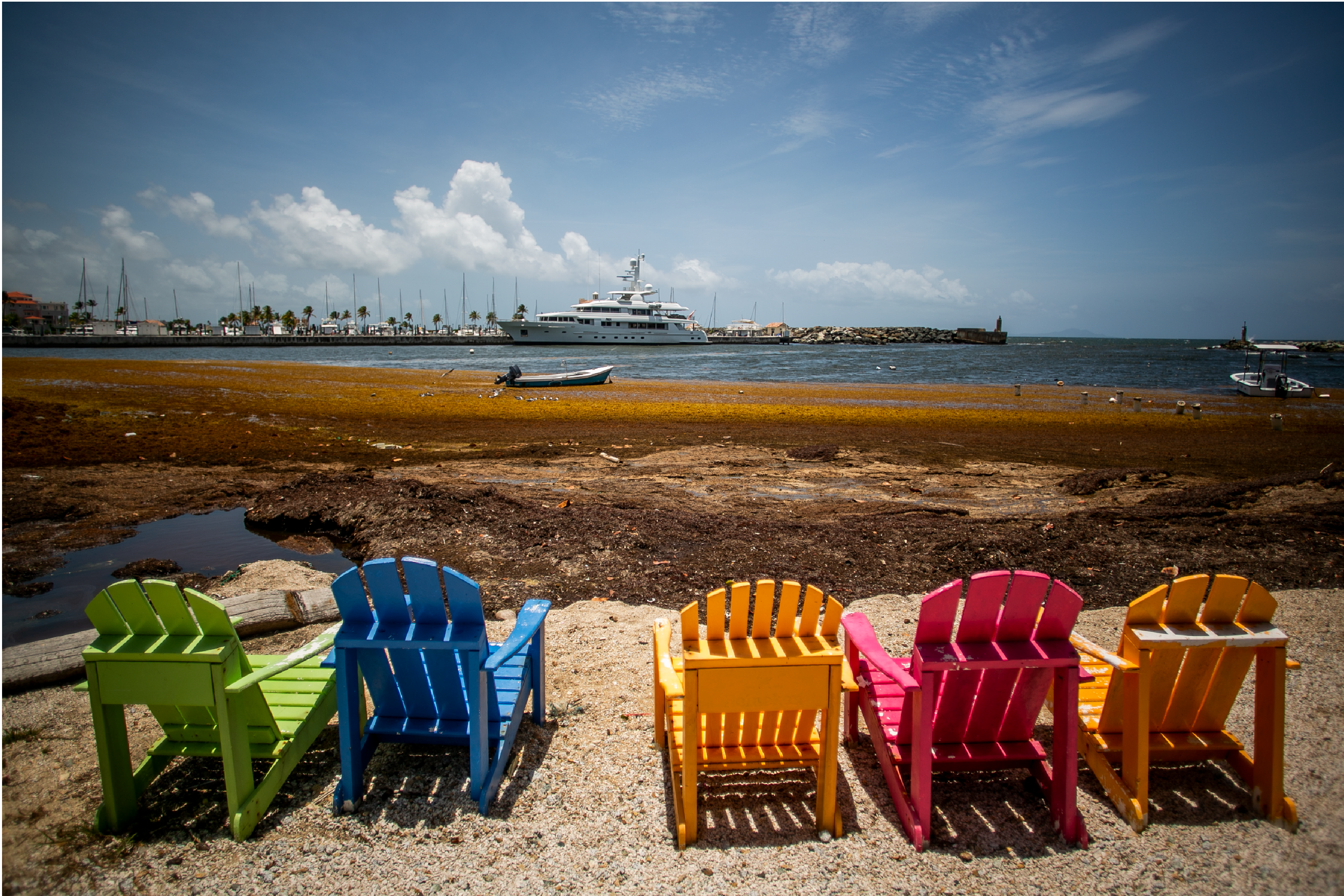The 2023 sargassum season started early at the Bolongo Bay Beach Resort on St. Thomas in the United States Virgin Islands.
Around the end of March, staff launched the response system they have devised over the years in the absence of any official guidance from the government: hand-raking the beaches and spreading the seaweed to dry on the grounds of the 65-room property, which is nestled in a cove on the southern side of the island of about 50,000 people.
As usual, the family-owned resort had to foot the full bill for the response.
It is not alone. Without a national sargassum management strategy or a dedicated pool of funding from the V.I. government, the financial burden for cleaning the shorelines in the territory has often fallen squarely on resorts, yacht charterers and other tourism operators.
“We’re in the millions of dollars being spent on mitigation over the last decade,” said Lisa Hamilton, President of the V.I. Hotel and Tourism Association.
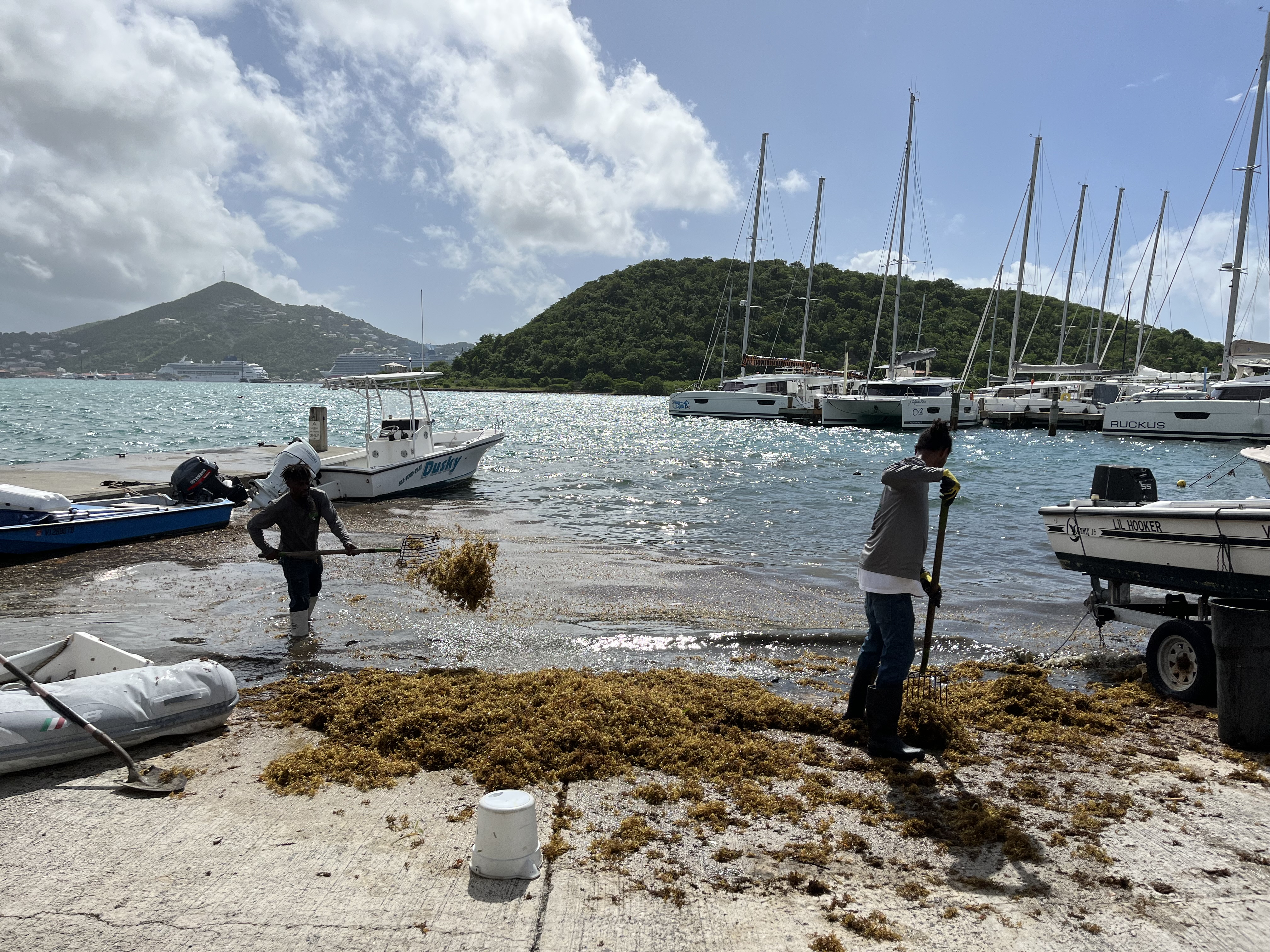
Workers with ORB Landscaping and Trucking use rakes and bins to haul massive piles of sargassum away from the Frenchtown boat ramp on St. Thomas on Oct. 20, 2023. They were called in for “emergency cleanup by the government.”
Photo by Suzanne Carlson | The Virgin Islands Daily News
Often these costs come on top of lost revenue as tourists increasingly select their vacation destinations to avoid affected beaches.
Variations of this scenario have played out repeatedly across the Caribbean since sargassum began to regularly swamp the region in 2011.
For example, tourism operators in Aguadilla, Puerto Rico, were among the 2023 victims. Last September, the municipality — which had been spared from major sargassum events in the past — was hit by its first major influx shortly after Hurricane Lee passed to the north in September. As a result, tourism virtually shut down on the popular Aguadilla beaches of Peña Blanca and Crash Boat for about a week, Centro de Periodismo Investigativo (CPI) found.
“When people come [to the beach] and see that and [smell] the odor, they go to other beaches,” resident James Ramos said while he cooked the popular barbecue chicken “pincho” skewers that he sells daily on Crash Boat beach. “This was one of the worst [sargassum events] I have ever seen.”
Without a government mitigation plan mandated by April 2023 but never produced, Aguadilla business owners worked to clear the seaweed themselves. But they said they had questions about how to respond, with no clear guidelines on its disposal and no government program to reimburse them for their lost earnings.
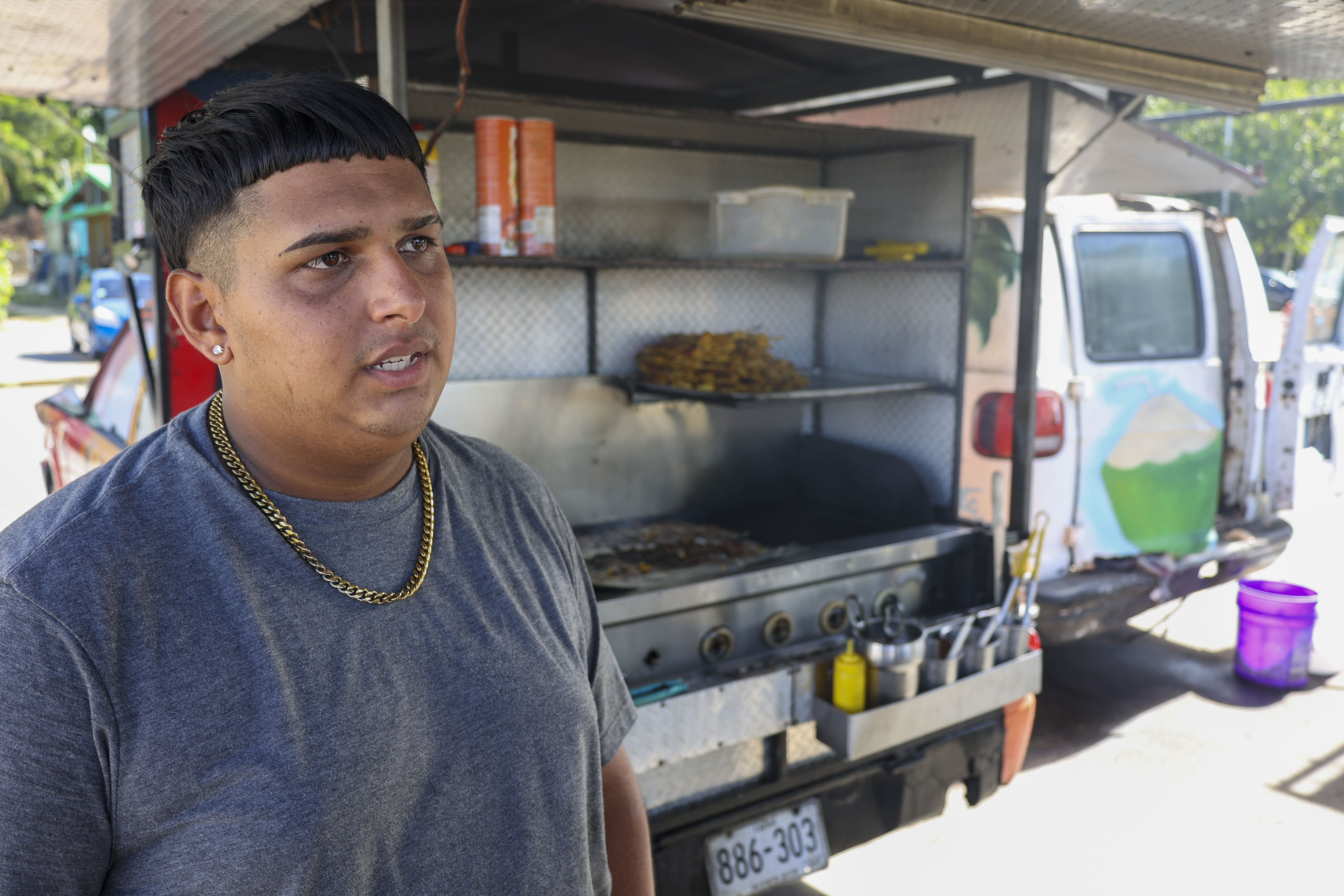
In Puerto Rico, James Ramos said that the arrival of sargassum kept people away from the beach where he has a business selling “pinchos”.
Photo by Gabriel López Albarrán | Centro de Periodismo Investigativo
The Puerto Rico Department of Natural and Environmental Resources (DRNA for its initials in Spanish) was ordered to prepare a mitigation plan for the management of sargassum under a law signed in January 2023 by Governor Pedro Pierluisi.
But that plan, which should have been ready by the start of April 2023, has stalled partly for lack of funding, said Mariana León Pérez, a researcher in marine and coastal sciences who was involved in the project’s early stages.
In its place, the DRNA recently published an updated and expanded action protocol for the management of sargassum that it initially created in 2015. But the protocol did not answer all the questions facing the affected Aguadilla businesses, whose struggles also point to larger issues about jurisdiction between the federal and local governments in the U.S. territory, according to León Pérez.
“[It is necessary] to clarify the jurisdiction; which permits are needed in terms of disposal of sargassum on land. That remains pending,” she explained. “We are already quite clear about what process must be followed to request permits for removal, but after you remove it, what do you do with it? So we have to clarify the disposition and use part.”
Aguadilla Mayor Julio Roldán said such issues presented a problem during the September accumulation.
“There were some people who own dairy farms who wanted to have sargassum, because it is a good protein for cows, but obviously they were not clear if that could be done or not. Since it was not specific in the [DRNA] protocol, it could not be achieved,” Roldán told the CPI.
“How bad is the sargassum?”
Studies have shown that Caribbean tourism drops by 7% to 35% during times of sargassum accumulation, and roughly 55% of all hotels in the region report being affected by sargassum, according to Dominican Republic-based oceanographer Elena Martinez.
Cleanup efforts — frequently funded by tourism properties desperate to keep their guests happy — often involve the use of heavy machinery on beaches. But this process exacerbates erosion, resulting in the need to invest additional millions of dollars in erosion restoration, said Martinez, who works as the research and development lead at SOS Carbon, an organization that designs systems to collect sargassum before it reaches shorelines.
Though total cleanup costs are unknown, they have been estimated to reach as high as $210 million in a single year in the Caribbean — a number the some researchers believe to be an underestimate.
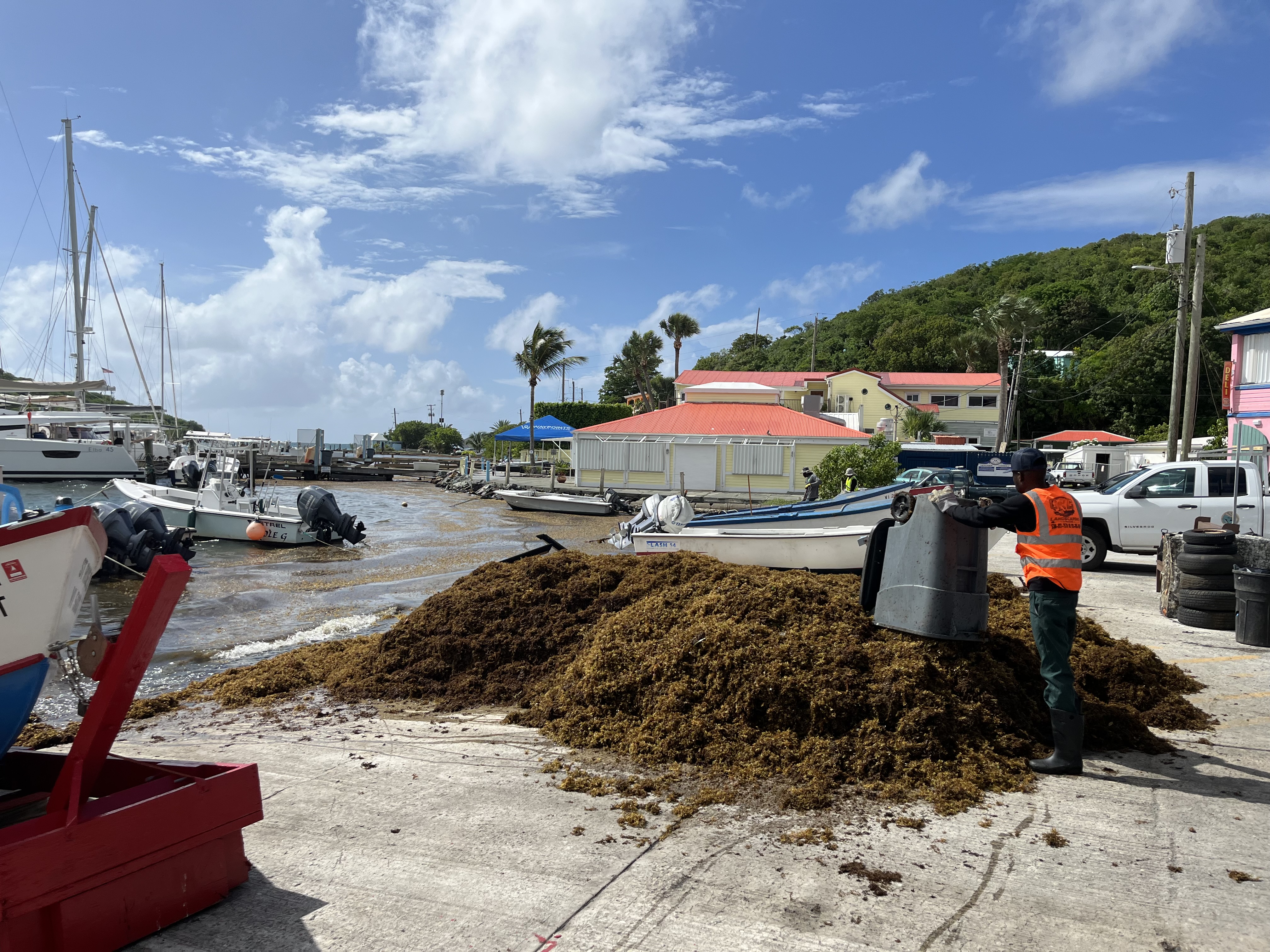
A worker piles up sargassum at the Frenchtown boat ramp on St. Thomas in the U.S. Virgin Islands on Oct. 20, 2023, after a late-season influx of seaweed that filled Charlotte Amalie Harbor, making it difficult for boats to navigate the busy port.
Photo by Suzanne Carlson | The Virgin Islands Daily News
Meanwhile, tourists planning a Caribbean vacation have been asking variations of the same question on travel websites and social media: “How bad is the sargassum?”
While several satellite tracking maps are available online, predicting where exactly an influx will occur is still challenging: Sargassum movements vary widely based on wind direction, currents, and other factors.
As a result, vacation planners have taken to social media to crowdsource answers to specific questions about where and when sargassum might hit. Also stoking travellers’ concerns are media reports, like a recent USA Today headline that warned, “A record-size blanket of smelly seaweed could ruin your spring beach trip. What to know.”
“Sargassum has a palpable effect on our tourism product and the people involved in the industry,” Dona Regis-Prosper, Secretary-General of the Caribbean Tourism Organization (CTO), told CPI. “When it’s heavy, our destinations suffer vacation cancellations and beachfront room closures, leading to staff layoffs and reduced economic gain for the sector and associated communities. Therefore, the sargassum invasion has had a negative impact on the tourist industry, the region’s main economic driver.”
Sargassum is more than just a nuisance, and can be associated with potentially serious health impacts. An April 18, 2023 air pollution alert in Capesterre de Marie-Galante in Guadeloupe warned vulnerable people to stay away from the coast, as the smell of decomposing sargassum made the air difficult to breathe. At times, such incidents have kept tourists away from the village and forced businesses to close.
Another wave of sargassum in Guadeloupe in September affected a populated marina with a variety of hotels, restaurants, and businesses offering water activities.
Last year in Jamaica, the popular tourist town of Negril experienced one of its worst sargassum seasons, which caused serious issues for beachfront hotels forced to spend thousands of Jamaican dollars to clean the beaches daily.
In the British Virgin Islands, the popular Nanny Cay Marina has tried using boats’ propellers to clear out the seaweed clogging its docks — a method that worked but proved expensive as gasoline costs mounted.
“Cleanup costs are prohibitive, with several destinations spending millions to restore the sociological and economic balance of affected areas,” said Regis-Prosper. “Kudos must be extended to those who have undertaken this challenging task and made strides toward recovery.”
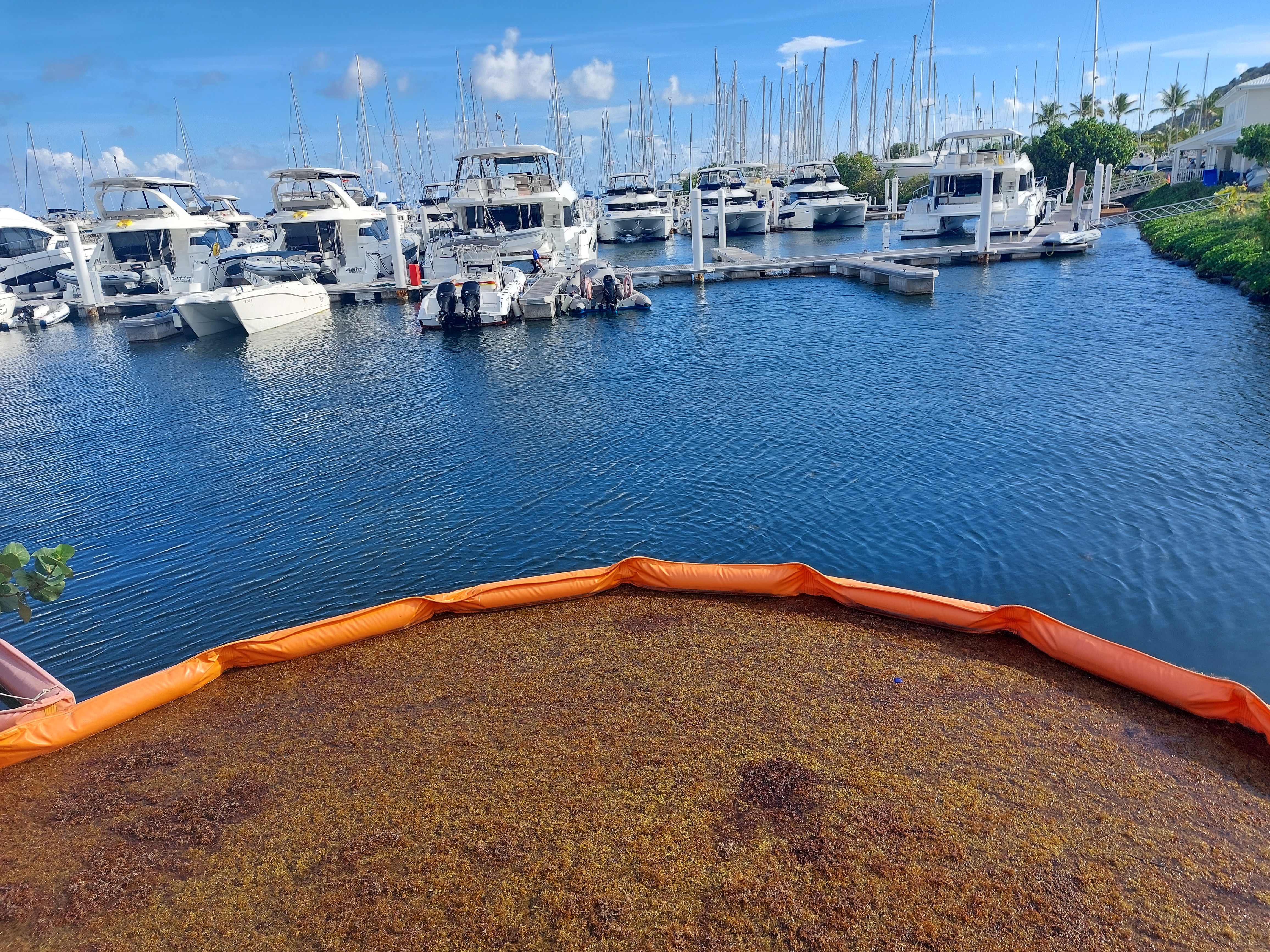
A boom holds sargassum back from yachts at Nanny Cay Resort and Marina in the British Virgin Islands on June 17, 2023.
Photo by Freeman Rogers | The BVI Beacon
She added that the CTO “applauds the efforts of organisations that are searching for and funding educational and start-up initiatives dedicated to repurposing sargassum to benefit our destinations. We will continue to encourage researchers, marine scientists, entrepreneurs and innovators to explore imaginative ways and means of managing sargassum by using it for carbon sequestration, agricultural use, and biofuel, for example.”
$25,000 per day
Until a large-scale solution is found, costs will likely continue climbing for tourism properties. In the U.S. Virgin Islands, no full spending breakdown has been made public, but a government official said in 2022 that the territory’s hotels collectively spent around $25,000 a day to clean up sargassum during major influxes.
Other numbers emerged during a public hearing in 2021, when environmental consultant Amy Dempsey said that the 264-room Margaritaville Vacation Club spends around $50,000 a month to remove sargassum, while the 180-room Ritz-Carlton spends more than $500,000 a year and removes as many as six 40-yard bins of sargassum in a day.
“Economically, for places like Margaritaville and a lot of the hotels on east-facing beaches, it is a major cost for them, the sargassum removal,” said Paul Jobsis, Director of the Center for Marine and Environmental Science at the University of the Virgin Islands. “And of course their guests don’t like it because it doesn’t feel good when you go swimming in a bunch of sargassum.”



